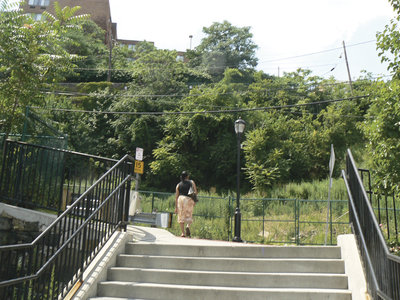After several delays and threats to its funding, a long-planned pedestrian stairway linking Jersey City and Hoboken finally made its debut on Nov. 6.
Pedestrians who wish to travel from the Palisade Cliffs in the Jersey City Heights to the Second Street Light Rail stop in Hoboken can now do so using a set of steps that link the two communities. Known officially as the “100 Steps,” the stairway provides a vital link to transportation, entertainment, and commerce between the two cities.
“We are pleased to cut the ribbon on this important project and officially open the 100 Steps to the public, providing a vital link between Hoboken and the Jersey City Heights,” Mayor Steven Fulop said last week. “Knowing how important this project is to the community groups in the Heights, who advocated for the 100 Steps for years, we worked quickly to see it completed.”
Former Mayor Jerramiah T. Healy held a groundbreaking ceremony for the project in June, shortly before the Fulop administration took office on July 1.
Reconnection
Until the 1920s there was a 100-step stairway that connected Hoboken to the Heights, known at the time as the Franklin Street Steps. This stairway was closed in the 1920s after the steps started to crumble and became unsafe. The original “100 Steps” were removed in the 1990s.
As Jersey City and Hoboken were redeveloped and began attracting New York City workers and people who wanted to commute easily between the cities, residents began lobbying for the stairway to be rebuilt.
Among the arguments made by Heights residents in support of rebuilding the steps was that the project would provide easier access to the area’s mass transit system. Residents would, for example, be able to walk to Hoboken and take the Hudson-Bergen Light Rail at the Second Street stop and access the PATH system, which is just a few light rail stops from Second Street.
Among the arguments made by Heights residents in support of rebuilding the steps was that the project would provide easier access to the area’s mass transit system.
____________
“One of the main reasons why people moved to the Heights is because of its proximity to Hoboken and New York,” said Becky Hoffman, president of the Riverview Neighborhood Association. “The 100 Steps project is essential to people getting to and from work, but also being able to go into Hoboken for restaurants and other activities. So it’s important to our local commerce as well.”
An opportunity and solution seemed to come along in 2003 when Brass Works Urban Renewal, the developer of the Cliffs Lofts at 100 Paterson Plank Rd., agreed to rebuild the 100 Steps as part of its development deal with Jersey City. Residents in the Heights hoped the stairway would be finished by the time the 120-unit development was completed in 2008.
As the estimated cost to rebuild the 100-step stairway rose from $250,000 to $700,000, however, Brass Works Urban Renewal told the city it could not afford to take on the project.
In 2010, the city agreed to take over the 100 Steps project from Brass Works Urban Renewal and, at the time, planned to use about $144,000 from the developer, plus a $300,000 New Jersey Department of Transportation (NJDOT) grant, and $256,883 in city funding to get the job done.
Some residents opposed this shift in responsibility from the developer to the taxpayers. Despite opposition, the city said in 2011 that it planned to have the steps completed by mid-2012.
Pathway between the cities
However, the project was put in jeopardy last year when the city failed to award a contract to the only company that bid on a request for proposals to build the steps. Under the terms of its grant from the NJDOT, the city had until July 3, 2012 to award a contract or lose the funding entirely.
The City Council refused to award the contract because the city had budgeted the project for $700,000 and the construction company submitted a bid for $1.7 million.
Last fall, the NJDOT agreed to extend the grant period for another six months to allow the city more time to rebid the contract.
“We (RNA) are very gratified to see the 100 Steps completed and in use,” said Hoffman. “They will shorten the commute for many area residents, and improve the fitness level of everyone who uses them. In addition, it is satisfying because…the previous RNA board fought to have the commitment for the Steps documented in a developer’s agreement, and the current board and our members made sure that this commitment was kept. While we believe the terms of that agreement required the Steps to be financed solely by the developer of The Cliffs, and not as it evolved to be paid for by a DOT grant, an assessment and city funds as managed by the previous administration – the completion of the Steps is important for the viability and economic growth of our neighborhood and we are very pleased that they are open and available for public use.”
In the end, according to city spokeswoman Jennifer Morrill, the project was completed with $250,000 from the developer; $300,000 from the NJDOT; $389,345 from the city; and a special assessment from the developer not to exceed $257,000.
E-mail E. Assata Wright at awright@hudsonreporter.com.
